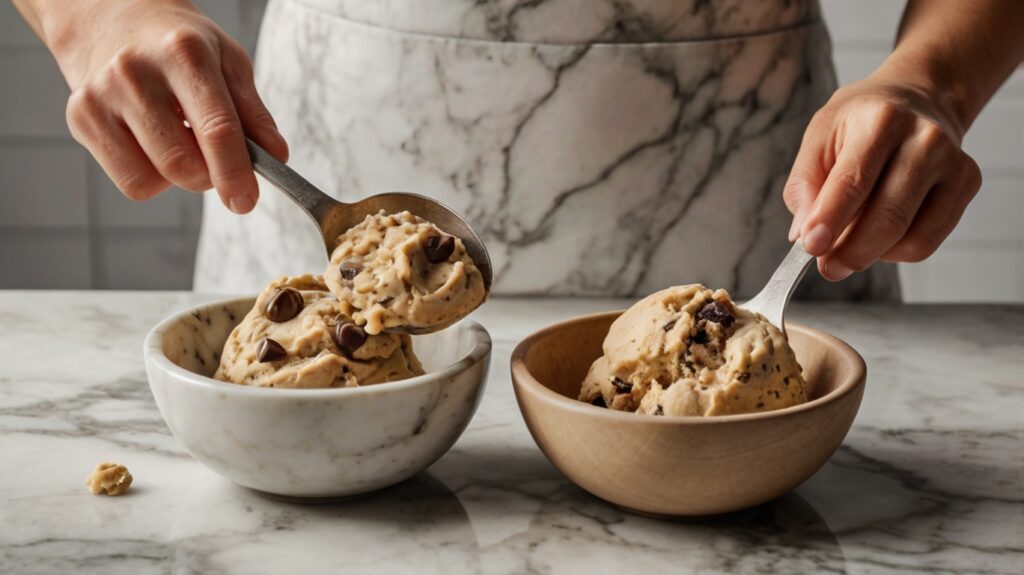Table of Contents
Difference between cookie batter and cookie dough
Understanding the difference between cookie batter and cookie dough is essential for both novice and experienced bakers. While they may seem similar, these two mixtures have distinct characteristics that significantly affect the outcome of baked goods. Whether you are making classic chocolate chip cookies or experimenting with new recipes, knowing when to use cookie batter versus cookie dough can make all the difference.
What is the Difference Between Cookie Batter and Cookie Dough?
Both cookie batter and cookie dough are foundational mixtures in baking, used to create a variety of delicious treats. However, the primary distinction lies in their consistency and the type of baked goods they produce. Cookie batter is typically more liquid-like and is used for lighter, airier cookies. In contrast, cookie dough is thicker and more solid, making it ideal for creating dense and chewy cookies.
To understand why you should use one over the other, it’s important to explore their differences in more detail. This article will break down these differences and guide you on how to use each effectively. Exploring the differences between batter and dough can give further insight into how ingredient choices influence the final product’s texture and taste. Additionally, understanding cookie dough vs. cake batter can provide insights into the nuances of dough, particularly how it contrasts with batters used in other baked goods.
Key Differences Between Cookie Batter and Cookie Dough
Consistency and Texture

Difference between cookie batter and cookie dough
- The difference between cookie batter and cookie dough largely revolves around their consistency. Cookie batter is generally thinner and more fluid than cookie dough, resembling a thick liquid. This is because it contains a higher proportion of liquid ingredients like milk and eggs.
- Cookie dough, on the other hand, is thicker and more solid, similar to a clay-like consistency. This is due to the higher proportion of dry ingredients, such as flour.
The difference in consistency is crucial as it affects how the cookies spread and bake. Batter-based cookies often spread out more and result in a flatter, crispier texture. Dough-based cookies, being thicker, maintain their shape better and are chewier and more substantial.
Ingredients Used
The ingredients used in cookie batter and cookie dough differ slightly, leading to their distinct textures:
- Cookie Batter Ingredients: Usually contains more liquids like water, milk, or buttermilk, which helps create a thinner consistency. Eggs are also common, providing structure and moisture.
- Cookie Dough Ingredients: Contains a higher proportion of flour, butter, and sugar, which helps maintain a thicker, moldable consistency. Often, the dough includes mix-ins like chocolate chips or nuts, which are easier to incorporate into a denser dough.
Preparation Methods

Cookie batter vs. cookie dough
- Mixing Techniques for Batter: Cookie batter is usually mixed with a whisk or beater to ensure the ingredients are well combined and the texture remains smooth. Overmixing can lead to the incorporation of too much air, which can cause the cookies to spread too much.
- Mixing Techniques for Dough: Cookie dough requires less mixing to avoid overworking the gluten in the flour, which can make the cookies tough. The dough is often kneaded or folded until the ingredients are just combined.
Uses and Applications
Understanding when to use cookie batter versus cookie dough is critical for achieving the desired outcome:
Uses of Cookie Batter
- Suitable for cookies that need to spread out and become crisp or have a lighter texture.
- Common in recipes like wafer cookies, lace cookies, or some types of sugar cookies.
- Unlike dough, cookie batter is typically not refrigerated before baking.
Uses of Cookie Dough
- Ideal for cookies that should hold their shape and have a thicker, chewier texture, such as chocolate chip cookies, peanut butter cookies, or oatmeal cookies.
- Refrigeration is often recommended for cookie dough to firm up the fats, which helps the cookies hold their shape during baking and enhances flavor. For more information, you can check out the impact of chilling on cookie dough.
Baking Techniques and Results

Baking Time and Temperature
- Batter-based Cookies: Typically baked at a lower temperature to prevent them from spreading too quickly and becoming too crispy. Baking time is usually shorter due to the thinner consistency.
- Dough-based Cookies: Baked at slightly higher temperatures to help set the shape and achieve a golden brown finish. They require a longer baking time because of their thicker nature.
End Products: Taste and Texture Comparison
- Cookie batter results in cookies that are lighter, crispier, and often more delicate in texture. The higher liquid content can lead to cookies that have a more uniform, even texture.
- Cookie dough creates cookies that are denser, chewier, and more substantial. The higher fat and flour content results in a cookie that has a richer flavor and a more satisfying bite.
Frequently Asked Questions
- What is the main difference between cookie dough and cookie batter?
The main difference lies in their consistency and the types of cookies they produce. The batter is thinner and more liquid, while the dough is thicker and more solid. - Can you use cookie dough instead of batter in recipes?
It depends on the recipe. Dough can be too thick for recipes that require a pourable consistency, and using batter in place of dough can result in cookies that spread too much. - How does chilling affect cookie dough?
Chilling helps the fats solidify, which prevents cookies from spreading too much and enhances the flavors. - Is cookie dough safe to eat raw?
Eating raw cookie dough is not recommended due to the risk of salmonella from raw eggs and E. coli from uncooked flour. - What types of cookies are best made with batter?
Cookies that require a lighter, crisper texture are best made with batter, such as lace cookies or thin sugar cookies.
What makes cookie dough?
What are the three types of cookie dough?
What is the difference between cookie batter and cookie dough?
What are the 15 common mistakes in making cookie dough?
Difference between cookie batter and cookie dough
Conclusion
Understanding the difference between cookie batter and cookie dough is fundamental for any baker looking to perfect their cookie recipes. By recognizing how the consistency, ingredients, and preparation methods impact the final product, bakers can make informed decisions and create delicious cookies that meet their texture and taste preferences. Whether using batter for a light and crisp cookie or dough for a thick and chewy treat, both options offer unique benefits and delicious results.
Difference between cookie batter and cookie dough




